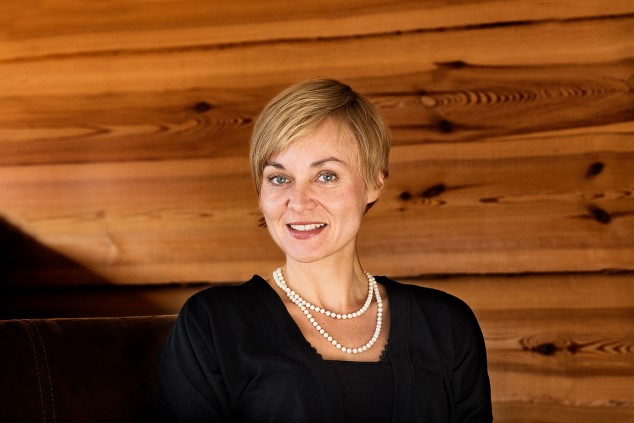International Women’s Day, on 8 March, is an occasion to celebrate women’s achievements, but also to look at areas where there’s still room for improvement.
In Germany, the percentage of women in management (i.e. members of management boards and managing directors) is being widely discussed: the current share of 29% is somewhat below the EU average (34%).
Frankly, InterNations doesn’t do any better than the average German company, though we don’t perform any worse, either. If we count our two founders and co-CEOS as regular members of our management board, three of ten board members are women. At 30%, this corresponds more or less to the national average.
The women on our management board are anything but average, though, and they have a lot to share about leadership in general, as well as women and leadership in particular.

Meet the InterNations Leading Ladies
Cornelia joined in 2017 as our new Head of Product Development, bridging business strategy with software engineering for our core product, the InterNations community. She is currently in charge of a team of seven, consisting of product managers, user experience designers, and visual designers, who together with our tech teams ensure the continuous development of our website and mobile apps.
As the Head of Content and Communications, Kathrin coordinates our entire content production process, from editorial content to social media to videos and more, as we usually produce everything inhouse instead of outsourcing to agencies. Consisting of eleven regular employees and a varying number of interns, her department is also responsible for all external and internal communication, as well as defining and — as she calls it — championing the InterNations brand (e.g. through corporate design). In 2016, she was appointed to represent these topics on the management board.
In her new role as the Head of Business Solutions, Theresa has been building a new business unit from the ground up, focusing on the B2B market to support global mobility professionals and international talent acquisition. At the moment, she’s managing a dozen employees from product development, sales and account management, and marketing, design & communications. Theresa originally joined the management board in 2012 when she became the first Head of Community Management at InterNations, and from 2016 to 2017 she worked on various projects in product and business development.

The Long and Winding Road to Leadership
None of the three women, however, necessarily envisaged herself in a leadership position from the get-go or took the most direct route to where she is now.
Initially, Kathrin pursued her interest in the humanities: While she graduated from the University of Cambridge, she did so with an MPhil in Literature and Culture. Starting at InterNations as a content editor with a one-year trainee contract even was a bit of a step back for her, as she already had previous work experience as an editor in an agency. However, since she’d focused on print publications for an artsy niche market, she was very eager to change careers.
“Witnessing first-hand the first big crisis of both print media and the music industry, I was pretty keen on moving into online content,” she remembers. “I also applied at InterNations because of the international environment. After spending ten years abroad, five of them in London, probably one of the most international cities in the world, I couldn’t imagine working in an all-German company anymore.”
Cornelia started her career with a student job in customer service at an online company. Due to personal reasons, she decided not to finish her degree course in business administration, but accepted the offer of a full-time position instead. Although she wasn’t yet thinking about what a leadership role might entail when she started out, she made use of every possible opportunity for personal growth, advancing her career to where she’s now .
Theresa is the only one to say she’d thought about maybe working in management one day when she began her career: “I think I’m quite an ambitious person, someone who wants to get ahead. I like assuming responsibility and making an impact; I enjoy organizational and strategic tasks, as well as working with people. This covers many aspects of leadership and probably helped me thrive in such a role.” However, she also mentions that she didn’t yet have any concrete plans for moving up the corporate ladder.

Staking Out A Claim in a Fast-Moving Corporate Environment
Another thing that Theresa, Kathrin, and Cornelia have in common: They all worked in a start-up environment, young companies with few, if any, established hierarchies, which were expanding rapidly. For Kathrin and Theresa, it was InterNations that provided this kind of work environment; starting with her student job, Cornelia was employed at FriendScout24, a large online dating platform, for about 15 years. Over time, they were growing into their leadership roles. This meant learning by doing, being flexible, shouldering additional responsibilities, and embracing new challenges.
Theresa began her career as one of three community managers when InterNations had about a dozen employees in total — interns included — with everyone reporting directly to Malte and Philipp, our founders and co-CEOS. Since the official events we’d introduced in selected communities were becoming ever more successful, we needed to hire more and more community managers. Theresa was instrumental in helping to grow the team, officially becoming the first Team Lead Events within one year of working at InterNations.
Another twelve months later, after establishing the InterNations Groups for smaller get-togethers and joint activities, she was promoted to Head of Community Management, uniting the Events Team, the Groups Team, and customer service in one department. “It certainly wasn’t easy,” she thinks. “In retrospect, more preparations, a formal pre-leadership training, or institutionalized support would have been a plus. It sometimes felt a bit like being thrown in at the deep end.”
Kathrin doesn’t mind that for her, too, the theory of management came a lot later than the practice. She’d gradually been staking out a larger area for herself: First, she was promoted from content editor and social media manager to team lead. Taking more and more tasks on board (e.g. video production and brand management), she eventually gained a seat on the management board.
“In a way, it was good to learn leadership skills on the job. Once I got to the theoretical background, I realized that by following my instincts and relying on common sense, I’d already done a lot of things right. But it helped me to reflect on what I was doing and to identify what still needed improving.”
Back at FriendScout24, Cornelia switched careers from customer service to product management, an organic development, as the support staff had been heavily involved in market research and user testing for a while. After the company changed owners several times, this somewhat tumultuous period resulted in teams getting restructured, her boss deciding to quit, and his replacement never returning from parental leave — but it also meant her chance had come. She was asked to head the same business unit where she’d been working as a product manager and to build a brand-new business division (a casual dating platform) in order to address a new target audience and increase the company’s market share.
Like Theresa and Kathrin, Cornelia needed to tackle a specific leadership challenge right from the start — supervising former colleagues. “Of course, this feels very different from being hired externally to manage a team you don’t know. I decided to address this head on. Before accepting the promotion, I spent a lot of time talking to the other team members. I explained that I wanted to do this, that I believed I could do it, but that I couldn’t do it without them. I needed their buy-in and wanted them to have my back.”

Management Styles: Personal or Gender-Specific?
Cornelia’s way of preparing for an important step in her career also touches upon a more general topic: personal management styles and how to excel as a leader. Interestingly, all three women describe their approach to leadership, as well as their expectations for succeeding in this role, in very similar terms.
“I’m trying to be approachable and supportive,” Kathrin says. “I want to be more of a mentor, someone who focuses on people’s strengths rather than the things they can’t do, helping them to gain confidence and improve their overall performance. It’s also important to involve your team in the decision-making process instead of thinking you know everything best. You don’t. It’s my job to keep the overarching goals in mind, but for the rest, I trust the experts on my team.”
Theresa, too, stresses the importance of supporting your team, especially if you are establishing a new department or business division. She has an open-door policy and does her best to be available for a brief talk or answering questions.
“On the one hand, I’m a very process-oriented person, who appreciates an organization where things run smoothly; on the other hand, I think it’s just as important to give positive feedback and show how much you value your team. In the end, you can’t motivate your employees — you have to create the right conditions for them to motivate themselves.”
Cornelia also prefers working with people who are intrinsically motivated. “I’m not a particularly authoritarian person by nature, and I’d rather have a company culture with flat hierarchies,” she states.
Even if they widely agree on the topic of leadership skills, they don’t necessarily believe in gender-specific management styles. They all make it very clear that if there are indeed any such differences between male and female managers, they are probably due to education and socialization rather than anything innate.
To be a well-rounded person with a knack for leadership, Cornelia argues, you need a combination of both stereotypically “masculine” traits, like assertiveness, and the soft skills traditionally considered more “feminine”, like empathy.
“Across the board, empathy might be a leadership skill than women have more often than men,” Kathrin suggests, “but I’m not sure. In any case, I don’t think that women are any less suited to management positions; they aren’t any less ambitious or less well educated.” This is a statement they’d definitely agree on.

Championing Women in Leadership Positions
As the statistics cited above show, however, women are lagging behind when it comes to management positions. What might explain this gender gap in leadership? Is there anything that could or should be done to change this? This is obviously a topic that all my interview partners have thought long and hard about, an issue they feel passionate about and have often discussed in their private life.
Women’s private life is also among the possible reasons to come to mind: All debates about gender roles notwithstanding, the average woman in Germany tends to do a larger share of so-called “care work”, such as household chores, raising children, or — another issue in an aging society — looking after elderly family members. Unless she has a very supportive partner or can afford “outsourcing” some responsibilities, the “second shift” at home may lead to her taking longer career breaks or working part time more frequently.
This isn’t just a problem to be solved by policymakers — for example, by generally providing better support for parents with young children. It’s also up to the business world to start thinking differently.
Depending on the respective sector or individual business, the corporate culture of many companies may still lack flexibility when it comes to such approaches as job-sharing or part-time positions in management. My interview partners also suspect that hiring managers might sometimes suffer from “tunnel vision”.
They might fail to notice promising candidates who don’t match the “manager” stereotypes, for example, soft-spoken introverts who could nonetheless do very well in some leadership positions; or they tend to hire based on past achievements rather than on personal potential. After all, a working mother with two kids under five knows a lot about flexibility, resilience, patience, and stress management.
Finally, Kathrin, Cornelia, and Theresa all regard quotas for women in leadership positions as the last resort. Society is changing, but it’s perhaps not changing fast enough. “I think we need an initial push,” Cornelia sums it up. “Just paying lip service doesn’t always work. Introducing regulations could help to normalize having women in management.”
In the end, diversity is also good for business, they think — not only with regard to gender equality, but also regarding other factors such as nationality, culture, education, race, and more. The more perspectives your company culture represents, the wider the range of opinions you get when making important business decisions and the easier it is to appeal to different people.
Photo credits: InterNations / iStockphoto
[…] Laura chose the right moment for her plan. “I happened to read in our blog that Cornelia, our Head of Product, had started out in customer support,” she recalls. So, she […]